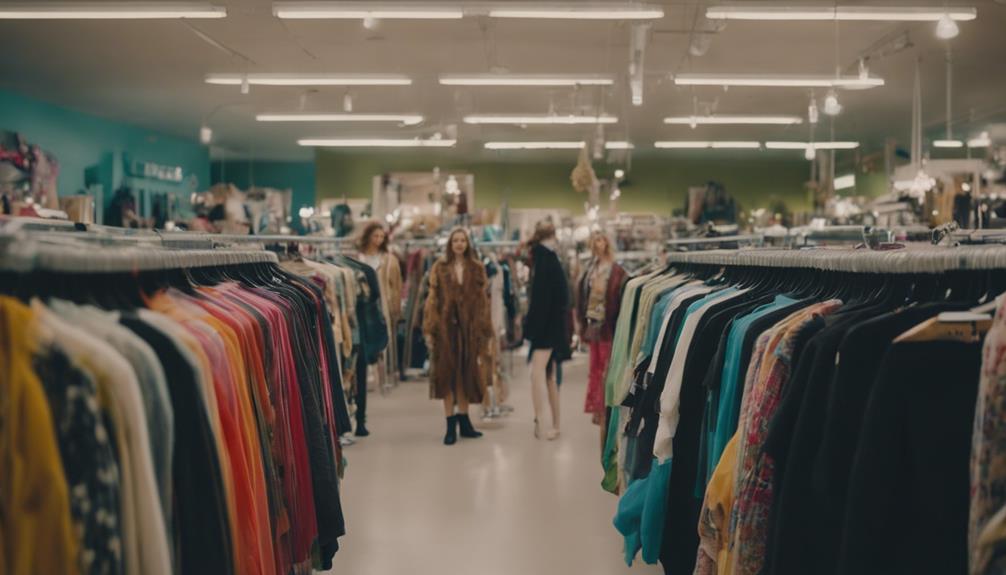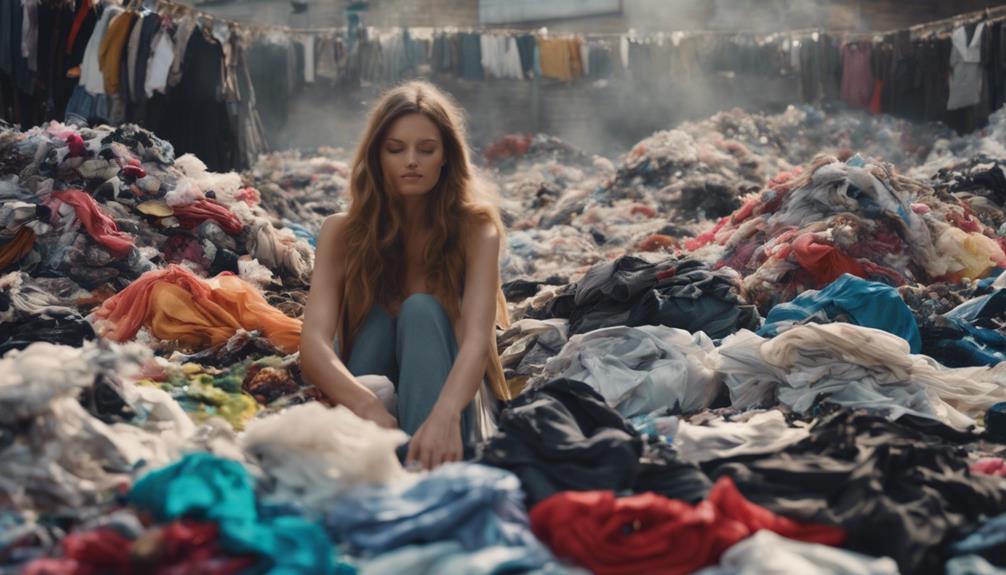Sustainable fashion can have its pros and cons that may impact your shopping decisions. One positive aspect is that it reduces environmental impact and promotes fair labor practices, encouraging advancements in sustainable materials. While investing in high-quality clothing can save money in the long run, there may be higher upfront costs. Moreover, the limited styles and presence of greenwashing can make it challenging to choose among options. Many consumers still prioritize affordability over sustainability, which adds to the complexity. Recognizing these challenges can empower you to make more informed decisions. Stay tuned for more insights to guide you through the realm of sustainable fashion.
Key Takeaways
- Pros: Sustainable fashion reduces environmental harm by lowering carbon emissions and waste production, promoting eco-friendly materials and practices.
- Pros: It supports ethical labor practices, ensuring fair wages and safe working conditions for workers in the fashion industry.
- Cons: Higher initial costs of sustainable materials and ethical production can deter consumers accustomed to fast fashion's low prices.
- Cons: Greenwashing and misinformation about brands' sustainability claims can confuse consumers and obscure genuine efforts.
Advantages of Sustainable Fashion
Sustainable fashion offers significant benefits by reducing environmental harm and supporting ethical labor practices, making it a responsible choice for conscious consumers. By choosing sustainable fashion brands, you're actively contributing to lower carbon emissions and a smaller environmental impact. For instance, organic cotton produces 46% fewer carbon emissions than conventional cotton, helping to diminish the fashion industry's overall carbon footprint.
When you invest in high-quality materials, you're not just getting a better product; you're also supporting ethical labor practices. These brands prioritize fair wages and safe working conditions for garment workers, contrasting starkly with the often exploitative practices seen in fast fashion.
Sustainable fashion encourages mindful consumption, prompting you to buy less but better. By valuing quality over quantity, you can enjoy longer-lasting products, which can ultimately save you money by reducing the need for frequent replacements.
As consumer awareness grows, the demand for sustainable practices drives innovation in eco-friendly materials and production methods, benefiting both the environment and society. By embracing sustainable fashion, you're making a choice that aligns with your values and promotes a healthier planet for future generations.
Economic Considerations

When you consider sustainable fashion, you might notice the higher initial costs can be a barrier.
However, investing in quality pieces can save you money in the long run, as they often last longer and require fewer replacements.
Still, affordability and accessibility issues remain significant factors that impact your choices in the fashion market.
Long-Term Financial Savings
Investing in high-quality, durable clothing can save you money over time by reducing the need for frequent replacements. When you choose sustainable fashion, you're not just making a style statement; you're also committing to long-term savings. By prioritizing quality over quantity, you can greatly decrease your spending on apparel.
Here's a quick comparison to illustrate the financial benefits:
| Sustainable Practices | Cost Impact |
|---|---|
| Durable clothing | Fewer replacements needed |
| Second-hand shopping | Lower overall spending |
| Renting clothing | Access to styles without high costs |
Initial Cost Challenges
The higher initial costs of sustainable fashion can be a significant hurdle for many consumers, especially with fast fashion's enticingly low prices. Sustainable materials, like organic cotton, often cost 2-3 times more than conventional fabrics, contributing to this higher price. Additionally, ethical labor practices demand higher wages for workers, which further increases production costs and ultimately the retail price of sustainable clothing.
Despite these initial cost challenges, investing in sustainable fashion can lead to long-term savings. The durability of these garments means they often last longer than fast fashion items, which can wear out quickly. By extending a garment's life by just nine months, you could cut its carbon footprint by 20-30%.
Consumer reluctance to pay a premium for sustainable options stems from the allure of fast fashion's low prices, creating a financial barrier to adoption. However, understanding the 'true cost' of fast fashion—hidden environmental and social expenses—can shift your perspective.
Affordability and Accessibility Issues
Affordability and accessibility issues in sustainable fashion can create significant barriers for consumers, particularly those with tighter budgets. You might find it hard to invest in sustainable options when prices soar due to ethical labor practices and the cost of sustainable materials. Fast fashion's low prices often lure you in, making it easy to prioritize affordability over sustainability.
Consider these challenges:
- Sustainable materials can cost 2-3 times more than conventional options.
- Ethical labor practices contribute to higher production costs.
- Thrift shops, usually affordable, are seeing increased prices.
These factors can discourage you from making sustainable choices, leaving you feeling frustrated and confused. While you may want to support sustainable fashion, the economic reality often pushes you back towards fast fashion, where the immediate savings are hard to resist.
To truly make sustainable fashion accessible, a shift in consumer education and industry practices is essential. After all, everyone deserves the chance to choose fashion that aligns with their values without breaking the bank.
Environmental Impact

Recognizing the fashion industry's role in generating 10% of global carbon emissions highlights the urgent need for sustainable practices to mitigate environmental damage. Fast fashion brands contribute notably to this issue, but adopting sustainable materials can lead to substantial improvements. For instance, organic cotton produces 46% lower carbon emissions than conventional cotton.
By embracing sustainable practices, you can also reduce water consumption, addressing one of the major environmental issues linked to textile production. The circular fashion model promotes recycling and reusing materials, which can help prevent the staggering 92 million tons of waste generated by fast fashion annually.
Here's a quick overview of the environmental impact of sustainable fashion:
| Aspect | Impact |
|---|---|
| Carbon Emissions | 10% of global emissions from fashion |
| Sustainable Materials | 46% less carbon emissions from organic cotton |
| Water Consumption | Notably reduced with sustainable practices |
| Waste Generation | 92 million tons from fast fashion annually |
| Carbon Footprint Reduction | 20-30% decrease with prolonged garment use |
Transitioning to sustainable fashion not only benefits the environment but also promotes a healthier planet for future generations.
Consumer Behavior Shifts

A significant shift in consumer behavior is driving the demand for sustainable fashion, as more people prioritize ethical choices in their purchasing decisions. Recent sustainable fashion news highlights that while many are keen to buy from sustainable brands, affordability remains a concern. In fact, 60% of shoppers still prioritize price over sustainability, indicating a strong need for affordable options.
This growing interest also reflects a desire for education on sustainable practices. Many consumers recognize the need to understand the implications of their choices but often find themselves overwhelmed.
Here are some key emotions driving these shifts:
- Empowerment from making informed choices
- Concern for the planet and future generations
- Frustration over the elitist perception of sustainable fashion
Post-2020 activism has played a significant role in raising awareness, yet only 25% of consumers fully grasp what sustainable fashion entails.
As you navigate this evolving landscape, embracing quality and longevity over quantity can lead to a more sustainable wardrobe and a brighter future.
Challenges in Sustainable Fashion

When you consider sustainable fashion, you might notice some key challenges that stand in the way.
Affordability and accessibility can make it tough for everyone to participate, while greenwashing often clouds the truth about what brands really offer.
Plus, the limited variety and styles available might leave you feeling like your choices are restricted.
Affordability and Accessibility Issues
Sustainable fashion often feels out of reach for many shoppers due to its higher price tags and limited availability in affordable options. You may find that sustainable brands cater mostly to affluent consumers, leaving others struggling to access eco-friendly choices. This affordability barrier can be frustrating, especially when you want to make responsible purchasing decisions.
Consider these challenges:
- Sustainable materials often cost 2-3 times more than conventional options.
- Thrift shop prices have surged, limiting second-hand options.
- Many consumers prioritize price over sustainability, complicating the consumer shift.
This perception of sustainability being elitist limits not just accessibility but also the potential for a broader consumer shift towards eco-friendly practices.
It's crucial to advocate for more affordable options and greater education around sustainable practices to make fashion truly inclusive.
If you're passionate about sustainability, pushing brands to offer better prices and accessibility can help pave the way for a more equitable fashion landscape.
Together, we can create a culture where sustainable fashion isn't just a luxury but a common choice for everyone.
Greenwashing and Misinformation
Steering through the world of sustainable fashion can be tricky, especially with rampant greenwashing and misinformation clouding your ability to make informed choices.
Many companies exaggerate their environmental claims, with the European Commission finding that 42% of such assertions are misleading. This makes it hard to identify truly sustainable brands. Brands like H&M, despite their Conscious collection, often lack transparency about their materials and practices, leading to significant consumer mistrust.
The fashion industry frequently promotes sustainability as a spectrum, leading to misconceptions. You might confuse 'less unsustainable' practices with genuine sustainability, which isn't the same. As a consumer, you might find yourself confused about what constitutes real sustainable practices, highlighting a pressing need for educational resources that clarify these distinctions.
The prevalence of misinformation further complicates your quest for authenticity. To navigate this landscape, it's crucial to research and fact-check claims made by brands. By doing so, you can debunk myths and make informed choices that align with your values, helping to foster a more transparent and trustworthy sustainable fashion market.
Limited Variety and Styles
Finding trendy options in sustainable fashion can often be challenging due to a limited variety of styles and designs. While the movement focuses on eco-friendly clothing, many brands prioritize timeless pieces over fleeting trends. This can leave you feeling frustrated when trying to express your personal style.
You might miss out on bold, eye-catching designs that fast fashion offers.
Limited options can make it tough to find the perfect outfit for special occasions.
The small sustainable fashion market means fewer brands to explore.
Shopping online for sustainable pieces might restrict your access to diverse styles.
Many sustainable brands emphasize durability and quality, but this often results in simpler designs. If you're used to the rapid turnover of trends in fast fashion, you might perceive these styles as less exciting.
While the commitment to sustainability is commendable, the limited variety can feel like a significant trade-off. It's important to weigh your desire for trendy options against the benefits of supporting eco-conscious brands.
Embracing sustainable fashion means being open to a different approach to style, even if it sometimes feels restrictive.
Industry Claims Vs. Reality

Fashion brands often tout their sustainability efforts, but the reality reveals a stark contrast between marketing claims and actual environmental impact. Despite their emphasis on sustainable fashion, the industry hasn't greatly changed its carbon footprint over the past 25 years. Conventional fashion still accounts for 10% of global carbon emissions, raising questions about the effectiveness of their claims.
Many products marketed as eco-friendly, like those labeled carbon positive or organic, often lack transparency regarding their actual production methods and environmental benefits. You might find that a considerable portion of these items is made from non-biodegradable, petroleum-based materials, which contradicts the very essence of sustainability.
Moreover, the prevalence of greenwashing makes it difficult to discern genuine efforts from mere marketing gimmicks. Companies often exaggerate or mislead consumers about their sustainability initiatives, leaving you wondering how accountable these brands truly are.
High-profile innovations in sustainable practices haven't led to measurable improvements in environmental impact, emphasizing the need for clearer communication and genuine commitment to sustainable practices. It's crucial to look beyond the labels and scrutinize the reality behind the claims to make informed choices.
Future Directions for Sustainability

To shape a truly sustainable future, the fashion industry must embrace systemic change that prioritizes eco-friendly practices over temporary fixes. This means adopting sustainable production methods and focusing on reducing the environmental impact of fashion. Regulatory changes are on the horizon, pushing brands to integrate sustainable practices into their operations. Your voice as a consumer plays a significant role here.
Consider these emotional aspects of sustainable fashion:
- The joy of wearing clothes made from ethically sourced materials.
- The pride in supporting brands that prioritize the environment.
- The hope for a cleaner planet for future generations.
As you demand genuine sustainable options, brands will have to step up their efforts. Innovations in design are shifting towards durability and ethical production, steering clear of fast fashion's fleeting trends.
Together, through your choices and support, we can drive the necessary changes in the industry. The future of fashion hinges on our collective commitment to sustainability, ensuring that both environmental and social concerns are addressed effectively.
Frequently Asked Questions
What Are the Pros and Cons of Sustainable Fashion?
You'll find sustainable fashion offers benefits like reduced environmental impact and better quality, but it can be costly and limited in variety. Weighing these factors helps you decide if it's the right choice for you.
What Are the Positives of Sustainable Fashion?
Sustainable fashion shines like a beacon of hope, offering you reduced carbon emissions, fair wages for workers, and durable clothing. By choosing it, you not only save money but also support a healthier planet and responsible practices. However, it’s important to consider the cons of sustainable fashion as well. While it does offer many benefits, it can also come with a higher price tag due to the ethical and eco-friendly practices involved in production. Additionally, the availability of sustainable fashion options may be limited compared to traditional fast fashion. It’s also important to be mindful of greenwashing, where companies falsely claim to be sustainable in order to attract customers. Despite these potential drawbacks, the positives of sustainable fashion far outweigh the negatives, making it a worthwhile choice for consumers looking to make a positive impact on the world.
Do People Really Care About Sustainable Fashion?
You might think many people care about sustainable fashion, and some do, but most prioritize price over sustainability. To shift perceptions, education and awareness about true sustainability are essential for broader acceptance and understanding.
What Are the Negatives of Ethical Fashion?
You might find that ethical fashion has its downsides. Higher prices, limited styles, longer wait times, greenwashing concerns, and accessibility issues can make it challenging for you to embrace sustainable choices fully.
Conclusion
In the end, embracing sustainable fashion isn't just a trend; it's a movement toward a healthier planet and a more mindful future.
While the challenges can seem intimidating, the benefits for our economy and environment far outweigh the cons.
By choosing sustainable options, you're not just dressing yourself; you're making a statement.
So, what'll you wear today? The choice is yours, and every decision counts in creating a better world for tomorrow.









